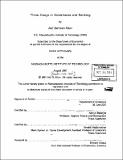Three essays in governance and banking
Author(s)
Mian, Atif Rehman, 1975-
DownloadFull printable version (7.569Mb)
Alternative title
Banking in Developing countries
Other Contributors
Massachusetts Institute of Technology. Dept. of Economics.
Advisor
Abhijit Banerjee and Sendhil Mullainathan.
Terms of use
Metadata
Show full item recordAbstract
This dissertation consists of three separate essays. In the first essay, privatization is found to improve bank performance by both better monitoring of existing firms, and improved selection of new bank clients. Data on firms borrowing from government-owned banks, and firms borrowing from a privatized bank suggest that privatization led to an improvement of 1 to 2 percent in the earnings-per-asset of firms financed by the privatized bank. Privatization influenced firms with weak outside options the most. Moreover, bank-debt became more responsive to expected profitability of firms after privatization. Finally, privatization significantly improved the ability of the bank to attract and select more profitable firms, with the newly selected firms having on average, 4 percent higher earnings-per-asset compared to other firms in their cohort. The second essay presents new empirical evidence on differences between domestic and foreign owned private banks in Africa. Domestic banks hold significantly more liquid assets, and are substantially less profitable than foreign banks. However, all of the difference in profitability can be explained by the 2.6% higher interest rate on deposits for domestic banks. Furthermore, domestic banks appear to take on riskier loans, but their return on loans is higher by 2.7%. Foreign banks on the other hand earn significantly more income through bank fees. Finally, domestic banks grow a lot faster than foreign banks with overall economic expansion in the country. A 1% growth in GDP expands domestic bank credit by 1.76% compared to 0.86% for foreign credit. (cont.) The third essay (joint with Daron Acemoglu and Michael Kremer) presents a theoretical analysis of the relative merits of markets, firms, and governments in environments where high powered incentives have both costs and benefits. Firms obscure information about workers' output, thus flattening incentives, and improving efficiency over markets. However in some cases, most notably under common shocks, firms are unable to commit to such a strategy. Under these circumstances, Governments may be able to commit to much flatter wage schedules, and improve the allocation of resources.
Description
Thesis (Ph. D.)--Massachusetts Institute of Technology, Dept. of Economics, 2001. Includes bibliographical references.
Date issued
2001Department
Massachusetts Institute of Technology. Department of EconomicsPublisher
Massachusetts Institute of Technology
Keywords
Economics.